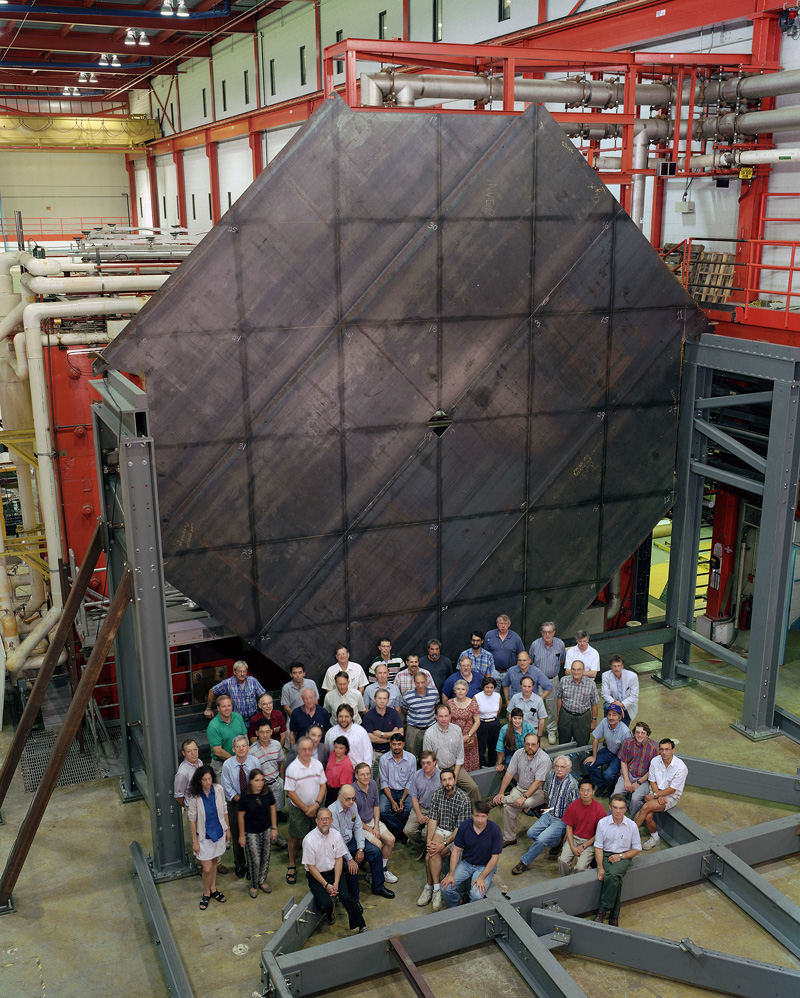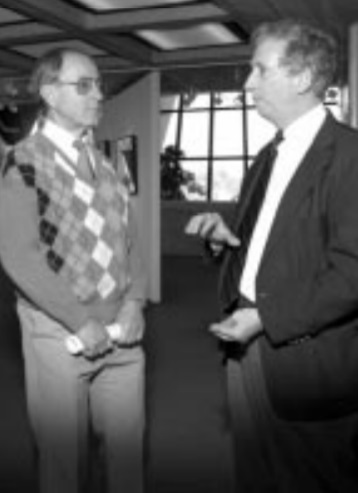NuMI: Glad Tidings
Baselining means NuMI experiment passes “GO” in new neutrino game.
For more than 20 years, the Standard Model gameboard has defined the rules in the Big Game of Particle Physics. But neutrinos show signs of playing by their own rules. They could overturn the board and have physicists playing an entirely new game, possibly moving from two-dimensional checkers to three-dimensional chess.
The next step for an ambitious confrontation with the Standard Model got the seal of approval in a second-floor conference room at Fermilab’s Wilson Hall on Friday, November 6, when Dan Lehman, Director of the Department of Energy’s Construction Management Support Division, told the assembled experimenters of NuMI (Neutrinos at the Main Injector): “You have your project.”
Completing an intense four-day investigation by a committee of 18 reviewers and four observers, Lehman recommended “baseline” status for the $136.5 million project. Baselining means DOE believes NuMI can be completed within the budget and schedule proposed by the experimenters, the essential approval before construction can begin.
“Extremely gratifying,” Fermilab Director John Peoples said of the approval. “The review went very well.”
“That’s baseline squared—the long baseline experiment achieves baseline,” exclaimed NuMI collaborator Stan Wojcicki of Stanford University.
NuMI’s long baseline extends 730 kilometers (about 438 miles), with a neutrino beam traveling an underground path between Fermilab’s new Main Injector accelerator and an 8,000-ton detector in a mineshaft at Soudan, Minnesota. The long baseline gives neutrinos the time and space they need to oscillate, or change identities.
Oscillations have been hinted at for more than 30 years by the solar neutrino deficit, in which the number of electron-type neutrinos is fewer than predicted; and more recently by the atmospheric neutrino anomaly. The ratio of muon neutrinos to electron neutrinos is about 2:1 in cosmic rays interacting in the earth’s atmosphere. But underground detectors such as Super Kamiokande (Super K) in Japan show a ratio closer to 1:1, and more recent Super K results have shown tantalizing additional evidence for neutrino oscillations.
“The results from Japan are absolutely a driving force for the whole physics community,” said NuMI Project Manager Tom Fields. “Clearly, it’s of the greatest importance to explore whether they’re really seeing neutrino oscillations, and if they are, to determine the difference in mass between the two varieties of neutrino they saw. Those are things our experiment is designed to do quite well. We could definitely be looking at physics beyond the Standard Model.”
In about five years (Fields believes the project can meet its original four-year target), NuMI will cash in on the capabilities of Fermilab’s new Main Injector to deliver an intense beam of protons in rapid pulses. The intensity and repetition at the Main Injector are major improvements over its predecessor accelerator, the Main Ring, an important factor given the rarity of neutrino interactions.
The reviewers had to examine three technical design reports: one prepared by the University of Minnesota for the excavation to place the detector in the mineshaft a half-mile below the surface at Soudan; another for the detector components, and the third for the tunnel construction at Fermilab.
When the experiment is running, the Main Injector will fire 120 GeV protons at an underground carbon target, producing pions and kaons. These particles will decay into muons and muon neutrinos as they speed along a 675-meter decay tunnel, angling downward 3.3 degrees. An absorber and a few hundred feet of rock will remove extraneous particles. The remaining muon neutrinos will pass through the near detector, about 1525 meters away from the Main Injector, leaving a record of the composition of the beam—which then passes beneath the director’s living quarters on the Fermilab site and travels through the earth to Soudan, Minnesota.
NuMI’s tunnel “takes us to places where we’ve never been before, posing a new set of challenges,” said physicist David Boehnlein, who edited the technical design report for the civil construction that comprises a large share of the project’s cost. The NuMI tunnel will run deeper below the surface than Fermilab’s accelerator tunnels. It will go through bedrock at the level of the local aquifer, and reviewers were especially meticulous in examining the project’s environmental safeguards.
The target area will be 125 feet below grade at Fermilab, compared to 30 feet for the Main Injector tunnel. The near detector will be 300 feet below grade—deeper than the height of 16-story Wilson Hall, and as deep as Chicago’s “deep tunnel” reservoir system. Fluor Daniel and Harza, the architectural engineering firm that constructed the deep tunnel, has been working on the NuMI design. Excavations at the Soudan site will begin in about four months. Excavations at Fermilab should start in the spring, with another DOE review set for May, 1999.
“A very few neutrinos will interact in our detector in Soudan, compared to the number produced,” Boehnlein explained. “We need such a large detector to assure a good statistical analysis. The rest of the neutrinos that don’t interact will just continue, perhaps to the next galaxy. Neutrinos just keep going and going and going, like the Energizer Bunny.”
But Fields will be winding down his project manager’s role. He was asked by Peoples last April to leave semi-retirement and shepherd the project through the baselining review. One of the reviewers’ recommendations was the quick naming of a successor. Fields has been part of NuMI since the original proposals in 1990, and at age 68, he will be happy to return to a collaborating role.
“There’s still plenty to do on the job list,” he said, “but it’s time for me to take another role in the project and let some of the younger generation do the managing.”





